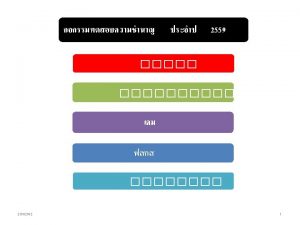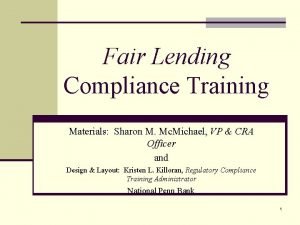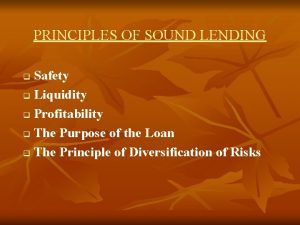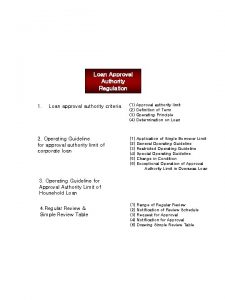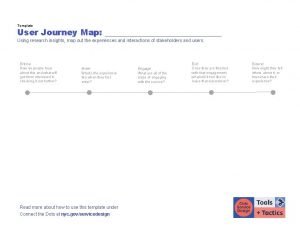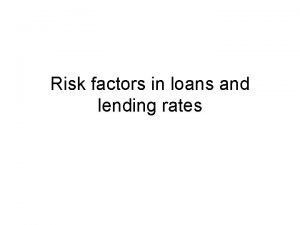Financial Analysis for Lending n The financial strength




























- Slides: 28

Financial Analysis for Lending n The financial strength of a borrower is very important in assessing his repayment ability. Therefore, credit officers often apply financial analysis in processing an application for credit facilities.

Financial statements n A trading and profit and loss account (or income statement) shows a company’s business operations in a period of time, which includes the information about the sources of revenue, the profitability of the business and the control of expenditures. A balance sheet shows a company’s assets and liabilities at a particular date, which includes the information about the company’s sources of capital and changes in assets and liabilities.

Financial statements n The tangible assets include those fixed assets like land buildings, plant and machinery, etc. and those current assets like inventory and cash. Intangible assets are rights and nonphysical properties like copyright, patents, goodwill, etc.

Financial statements n Quality of assets held by a company must be of acceptable standard. This can be assessed by taking a conservative valuation of the assets as at a specific date. Moreover, the components of the assets profile should be compared over some periods of time and against similar companies in the same industry.

Financial statements n Liabilities are divided into shortterm liabilities, i. e. the debts to be repaid within one year, and long-term liabilities, i. e. the debts to be repaid over more than one year.

Financial statements n Capital is the amount of money that has been invested by the owners and retained earnings are the net profits which have not been distributed as dividends to the shareholders.

Financial statements n Sales figures (or turnover) indicate the earning power of a firm’s operation. Comparison can be made with the percentage increase or decrease of sales over some periods of time.

Financial statements n Working capital demonstrates the liquidity position of the firm which is relevant to the level of insolvency risk. The analysis of cash flow suggests the ability of the business to service loan repayments and fixed assets acquisition.

Financial statements n Net worth shows a company’s capital structure as well as both long-term and short-term debt burdens. The credit officer should examine the equity position and dividend policy carefully.

Financial Analysis for Lending n The lending banker should identify the company’s investment strategies to study the implications for the company’s present and future financial position. A company’s short-term investment will affect its cash management policies and liquidity position. For example, substantial short-term investment in the stock market may be an indication of speculation, which can dry up the company’s liquid funds.

Financial Analysis for Lending n Whereas the company’s long-term investment, such as capital investment programs, will determine the financial resource requirements. If internal financing, i. e. from retained earnings, is insufficient, the company has to seek external financing which may raise the degree of gearing.

Accounting ratios Financial statement interpretation focuses on absolute figures while ratio analysis interprets the relationship between financial variables. The credit officer can use the ratios to compare : a. the trend which takes into account the past, the present and the future potential of the company; b. the borrower’s operations with other business operations within the same industry. n

Liquidity ratios n Liquidity ratios indicate the liquid position of the company : Quick ratio measures the short-term realized liquidity and current ratio measures whether the current assets are available to cover the current liabilities when due.

Debt ratios n Total liabilities to total assets ratio shows the commitment of the firm to external creditor. Debt to equity ratio reflects the strength of the capital structure and the degree of the firm’s gearing.

Profitability ratios n They measure the profitability in terms of sales, total assets and shareholder’s equity.

Cover ratios Interest cover ratio (earnings before interest and tax to interest expenses) measures the cost of servicing interest expenses. Debt service ratio (net profit and depreciation to amortization of debts) measures the loan payment ability of the firm.

Activity ratios Debtors turnover measures how many times the receivables have been turned over into cash during the year. Inventory turnover measures how many times the inventory has been sold during the year and the tendency of overstock.

Cash flow statement n Cash flow statement is a forecast of the inflows and outflows of cash for a future period of time. The net inflow represents cash surplus and the net outflow represents cash deficit. The company has to plan to deal with the cash deficit, such as arranging for a current account overdraft or short-term loan.

Cash Flow Statement Format Cash Inflow Items : E. g. Sales, Disposal of Assets Cash Outflow Items : E. g. Purchases, Expenditure Cash Surplus / Deficit Accumulated Cash Balance

Z Score n The Z score was created by Edward I. Altman to discriminate between the bankrupt and non-bankrupt companies. It is a good analytic tool no matter what shape a company is in. To calculate the Z score, we have to find the following four ratios.

Z Score X 1 = Working Capital / Total Assets X 2 = Retained Earnings / Total Assets X 3 = Earnings Before Interest and Tax / Total Assets X 4 = Net Worth / Total Liabilities

Z Score The working capital is derived from total current assets less total current liabilities. When a company experiences financial difficulty, working capital will fall more quickly than total assets. Retained earnings measure the cumulative profitability of a company. When a company begins to lose money, the value of total retained earnings begins to fall.

Z Score The return on assets is a measure of profitability and a measure of how productively a company is using borrowed funds. If the ratio exceeds the average interest rate that a company is paying on loans, the company is making more money on the loans than it is paying in interest. The X 4 ratio is the inverse of debt-to-equity ratio. Failure in business always results in the accumulation of debts.

Z Score After we have calculated the four ratios, we simply multiply them by their related coefficient, and add the results, then compare the total to some benchmarks which are the cut-off values developed by Altman.

Z Score Ratio Coefficient Bankrupt X 1 6. 56 (0. 061) Nonbankrupt 0. 414 X 2 3. 26 (0. 626) 0. 355 X 3 6. 72 (0. 318) (0. 154) X 4 1. 05 0. 494 2. 684

Z Score Cut-off Values Mean Scores Safe if greater than 2. 60 Non-bankrupt : 7. 70 Bankrupt if less than 1. 10 Bankrupt companies : (4. 06)

Z Score The purpose of calculating the Z score is to warn both the banker and the company of the financial situations and to provide a guide for action. The banker can observe the trend of the Z scores of a company over some periods of time to understand what has changed in the financial situations, and compare the Z score of a company against those of other companies in the industry to understand the company’s position and performance in the industry.

Tutorial Exercise Ratio Calculation 2001 2002 ROS: Gross Profit / Sales Net Profit / Sales 6. 7% -17. 5% 13. 7% -2. 6% ROA: Net Profit / Total Assets -20. 3% -2. 9% ROE: Net Profit / Shareholder’s Equity -81. 5%
 Yield and tensile strength
Yield and tensile strength Percentage strength w/v
Percentage strength w/v Half strength darrow's
Half strength darrow's The percentage strength means gram in
The percentage strength means gram in Illegal money lending team
Illegal money lending team Sla servicing student loans
Sla servicing student loans Relie check
Relie check Fair lending compliance training
Fair lending compliance training An institution for receiving, keeping, and lending money
An institution for receiving, keeping, and lending money Basic principles of lending
Basic principles of lending Canons of lending are
Canons of lending are Community partners loan pool
Community partners loan pool Lending policies and procedures managing credit risk
Lending policies and procedures managing credit risk Socially responsible lending
Socially responsible lending What are the principles of sound lending
What are the principles of sound lending Life below zero: bank lending under negative policy rates
Life below zero: bank lending under negative policy rates Jblm reassignments
Jblm reassignments Principles of lending
Principles of lending Alejandro labrador
Alejandro labrador Forms of international lending
Forms of international lending Securities lending and borrowing example
Securities lending and borrowing example Blr bank
Blr bank Approval authority
Approval authority Federal reserve system
Federal reserve system Ffiec fair lending examination procedures appendix
Ffiec fair lending examination procedures appendix Vcf financing
Vcf financing Customer journey map template doc
Customer journey map template doc Relie responsible lending and insights engine
Relie responsible lending and insights engine Relie responsible lending and insights engine
Relie responsible lending and insights engine
